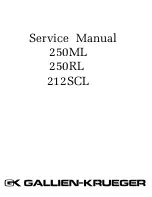
7
Operating Manual - nX, nXe, and nXp 150W/75W Power Amplifiers
2 nX INSTALLATION REQUIREMENTS
Before connecting to AC mains power, make sure that the mechanical installation, cooling requirements, wiring, controls, and
software are all set to the configuration needed for your particular application. Failure to do so could result in damage to the
unit or to other components in the system.
2.1 AC Mains Voltage, Power, and Current Requirements
The switch mode power supply (SMPS) with active power factor correction (PFC) auto-detects nominal mains voltage from 100-
240VAC, 50-60Hz. Operating range is from 70-270VAC. Use only the provided AC line cord to connect to AC mains. Programmable
power-on delay is available on nXe or nXp models. All models have a fixed, non-defeatable warm-up delay of several seconds to protect
against in-rush current when first powered up or when waking from sleep. The model number and power consumption are indicated
on the side panel label near the AC inlet. For best performance, all sound system ground references should originate at the same AC
power distribution point.
For safety, do not lift or remove the amplifier power cord ground pin.
Total Mains Power Draw and Maximum Current Draw
-
Total AC power consumption and maximum 120VAC current
draw are shown in the specifications table in section 15, measured at 1/8th maximum output power under typical amplifier status and
load conditions, all channels driven using typical audio signal. For 240VAC current, divide 120VAC values in half.
2.2 Input Signal Wiring
Use shielded wiring for balanced or unbalanced audio signals. Shielding which is properly grounded will protect the signal from
outside electrical interference such as RF, fluorescent lighting, and computer/display emissions. Unbalanced or single-ended (tip-
sleeve) wiring should be less than 10 feet, longer lengths should use balanced wiring.
To connect an unbalanced input signal to the amplifier input, wire the input (+) to the input (+) euroblock pin, and the input shield
to (-) and to ground. Do not leave the (-) input unconnected. If there is ground loop hum, try connecting the shield only to the (-)
input pin and leave the input ground pin floating. Avoid running low level signal wires in close proximity or parallel to long speaker
cables, AC power cables, or power transformers, as they can induce hum and oscillation.
2.3 Output Speaker Wire
Connector type:
This amplifier uses a four-pin 300mil (7.62mm) Euroblock connector for speaker outputs. For bridged mode, use
the two center pins as labeled.
Wire class:
Class 2 speaker wiring is sufficient to meet electrical code requirements, with the exceptions of 70V or 100V
bridged
mode
output, which requires class 3 wiring since output voltage may exceed 120V. This is based on UL 60065 section 5.2-d and the
US National Electrical Code Article 725. Consult local code for exact requirements.
Wire guage:
Insufficient wire gauge, especially over long distance, adds resistance to the speaker’s own impedance, reducing the
power delivered to the speaker. Since power at the speaker load is of primary concern in system design, refer to the table below to
best determine appropriate wire gauge for your application. The following table lists the resistance per 100 feet of common copper
wire gauges, and also lists the percentage of the speaker load power which would be lost as heat in an arbitrary 100 ft run of different
gauges of 2-conductor copper speaker wire.
Wire gauge resistance/power loss for 100ft speaker cable
Wire Gauge Ohms/100ft
8 Ohm load
4 Ohm load
2 Ohm load
#8
0.0605 Ohms
0.8%
1.5%
3%
#10
0.1018 Ohms
1.3%
2.5%
5%
#12
0.1619 Ohms
2.0%
4.0%
8%
#14
0.2575 Ohms
3.2%
6.4%
12.8%
#16
0.4094 Ohms
5.1%
10.2%
20.4%
#18
0.6510 Ohms
8.1%
16.3%
32.6%
This table expresses the power loss as a percentage of the load’s power rather than the total amplifier output power in order to ac
-
curately determine power loss at other cable lengths. For example, if you plan to deliver 150 watts to an 8 Ohm load through 50 ft of
14 ga. cable, the power loss in the cable would be half that of a 100 ft run of #14 wire as shown in the table, or 1.6% of 150W, which
is an insignificant 2.4 watts. However, if you were to run 200 ft of 18 ga. cable to a 2 Ohm load, the loss would be twice that of the
100 ft run shown in the table, or 65.2% of 250W, which is 163 watts lost as heat. Always be sure to use adequate gauge speaker wire.








































